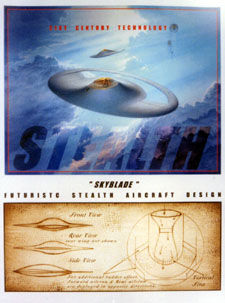


| Richard Marmo's SCALEWORLD |
Rumors, we love rumors, we love lots and lots of rumors. Lately, a series of rumors concerning REVELL-MONOGRAM have been making the rounds. You've heard'em: Revell-Monogram is being sold to either a holding company or an individual; the Monogram label is dead; the Do-217 and F-86D kits have been canceled and there won't be any more new aircraft kits.
In order to get to the bottom of things, I spoke with Ed Sexton, Product Development Manager at REVELL-MONOGRAM. A pleasant and informative conversation resulted in the following:
REVELL-MONOGRAM is currently in negotiations with an individual. No agreement has been consummated at this writing.
The MONOGRAM label is not dead. Over the coming weeks and months, the Monogram label will likely see increased use. The new Monogram ProModeler 1/24 scale 1940 Ford Convertible was quoted as an example.
You will definitely see the Do-17 and F-86D. They've been delayed in order to make sure everything is right. As it now stands, the Do-17 should make the currently announced release date. The F-86D still needs some more work but I've been told that it will be state-of-the-art.
Last month, I asked for your input on a 1/48 scale aircraft survey and promised that responses would be tabulated in the June issue of Scaleworld…if there were enough replies. Well, there weren't. So, let's try again. Please list your top three choices (and ONLY three choices) in each of the following categories. As before, IF enough responses are received, I'll tabulate and publish the results in the next Scaleworld.
1/48 AIRCRAFT WITH MULTIPLE VARIANTS
1/48 AIRCRAFT WITHOUT SIGNIFICANT VARIANTS
1/48 CONVERSION / CORRECTION / ADD-ON SETS
1/48 COCKPIT DETAIL SETS 1/48 DECAL SETS
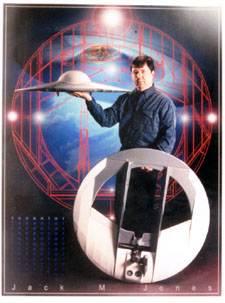 Model
builders are always on the prowl for strange and unusual subjects. This
holds true whether you build WW-II aircraft or Fantasy. Well, hang onto
your hats, folks, I've got a good one for you.
Model
builders are always on the prowl for strange and unusual subjects. This
holds true whether you build WW-II aircraft or Fantasy. Well, hang onto
your hats, folks, I've got a good one for you.
GEOBAT is about as fascinating an aircraft design concept as has come along in years. Conceived by Jack M. Jones, who is an artist and not an aerospace engineer, his design has drawn the attention of the military. It's also been chosen by the Discover Magazine Awards for Innovative Technology as one of the top 10 for the year 2000. Way to go, Jack!
The Geobat is a circular wing concept, or flying saucer if you prefer, that will grab your attention. Actually described as a three wing circular planform body, it's already been flown as a radio controlled, 40" diameter, gas powered model. In a home video that Jack has produced, the model takes on flight characteristics in the air that are virtually identical to descriptions of UFOs over the last 53 years.
Those of you interested in building and flying a Geobat of your own can obtain a full set of plans from Jack Jones for the paltry sum of $39.00. What you get for the money are three 24 x 42-inch sheets of plans. A 28-page construction manual is an additional $12.00. And a copy of the video that I mentioned is $15.00. Keep in mind that this design is highly flexible within certain parameters. Power can be either gas or electric, even a solar powered electric motor is feasible.
Prefer not to deal with a flying model? Then take a look at Jack's Skyblade concept. A military stealth aircraft design, it's projected propulsion can be either ducted fan or jet. You'll have a lot of latitude if you decide to tackle a static scale (1/48?) "what if" model of Skyblade. The reason for that is the design only exists to date as an artist's concept. Landing gear configuration has yet to be worked out, among other things.
By the way, if you think the Geobat design reminds you of something, you're right. Think back to the late 40s and early 50s and a company called Chance Vought. Now think of the XF5U Flying Flapjack. Granted, it was decades ahead of its time, but it was still a circular planform.
Is the Geobat and Skyblade ahead of their time? Only time will tell, but we could well be looking at the future of aviation…or at least one branch of it. Check out Jack's web site and form your own opinion.
As the Internet expands, we modelers seem to be spending more and more time online. Well, instead of running a mouse all over your desktop, constantly going back and forth to the keyboard and potentially setting yourself up for carpal tunnel surgery, let me suggest a better way.
Several years ago, a company called CIRQUE developed a little item called a GlidePoint touchpad. You've seem'em, even if you didn't know it. They're getting fairly common now on laptop computers and take the form of a small, smooth surface square. You control the cursor by gliding your finger lightly over the surface and touching lightly (hence the name touchpad) to 'click'.
The first touchpad I had was a standalone replacement for the ubiquitous mouse. And it was a dandy. Took me about three or four minutes to adapt to it and I was hooked. No more rolling a mouse around a desktop, no more cleaning dirt and fuzz out of the ball and socket, it was great.
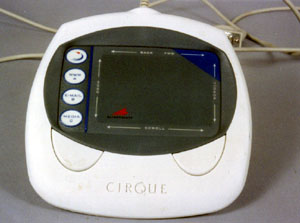 Since
then, CIRQUE has developed an entire line of replacement touchpads, along
with a keyboard that contains an integral touchpad. Prices range from
$39.95 to $69.95 for the touchpads and $84.95 for the keyboard. Incidentally,
keep your eyes open when shopping because one computer store I was in
had priced one some $30 higher than the MSRP.
Since
then, CIRQUE has developed an entire line of replacement touchpads, along
with a keyboard that contains an integral touchpad. Prices range from
$39.95 to $69.95 for the touchpads and $84.95 for the keyboard. Incidentally,
keep your eyes open when shopping because one computer store I was in
had priced one some $30 higher than the MSRP.
Since I had been using an original version for several years and was spending more time on the internet, I figured it was about time to upgrade. So, I picked up their latest effort, a CIRQUE Cruise Cat Internet Touchpad. Priced at $64.95, this little feline does just about anything you need it to do without moving your hand away from it.
While looking at first glance like you're about to wrap your hand around the stick of an F-16, it really ain't that bad. Designed to be plug-and-play compatible and with a provided adaptor to allow connection to either a PS/2 or Serial Port, it'll work from the get go. There's also a disk containing drivers and utilities to allow you to set up all the hot buttons and advanced features. And let's not forget the training program that'll help you develop just the right touch for optimum use.
Ultimately, you'll be able to connect to the web, check email and access various media programs with nothing more than the touch of one finger. Same goes for moving forward and/or back on web sites, scrolling both vertically and horizontally, even zooming in the appropriate applications. If that's not enough, there's a hot button that allows you to program gestures that you draw on the touchpad with your finger so you can access specific programs or files.
I could go on, but I'm beginning to sound like a CIRQUE salesman, which I'm not. But I do like touchpads to the point that I have no desire to go back to a mouse. Try one and I think you'll reach the same conclusion.
It used to be that when you started to paint a model, you reached for a bottle of paint and a paintbrush…a real paintbrush, one with bristles. Today, most of us reach for our trusty airbrush. And usually it's a question of which airbrush because we've learned that not all airbrushes are equal. Some handle heavier, thicker fluids and have difficulty attaining a fine, clean line separation. Other are designed for thinner fluids and can spray a line that approximate those produced by a ball point pen.
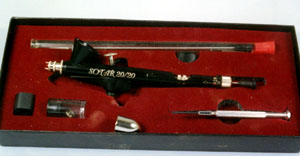 Falling
more or less into this latter category is a gorgeous brush from BADGER
AIRBRUSH called the SOTAR 20/20. This little jewel is self-described
as "the finest airbrush ever made" and I'm inclined to agree.
Falling
more or less into this latter category is a gorgeous brush from BADGER
AIRBRUSH called the SOTAR 20/20. This little jewel is self-described
as "the finest airbrush ever made" and I'm inclined to agree.
Available in two versions (each with three nozzle sizes), this brush deserves your serious consideration if your modeling emphasis is on very fine lines and clean color separations. And it will be a serious consideration when you learn that it retails for $395.00. It ain't cheap, but you wouldn't expect a high quality fine arts airbrush to be priced any other way.
Now that you've decided to spring for one, what do you get for your four C-notes. A box containing the Sotar airbrush, trigger pad, spare needle, alternate spray regulator with protective arms, an optional rubber finger rest and a screwdriver. Everything is fitted into individual scarlet foam nests.
The airbrush in the photo is a 20/20-2, being different from the 2020-1 only in the size of the paint cup (the -2 is larger). Mine has the fine nozzle, denoted by the black molded knob on the needle. I've also installed the alternate spray regulator.
It's a sturdy, solid airbrush, with the entire body made of metal. The cutaway handle design means you no longer have to remove the handle to remove the needle. But you've heard all this before because the BADGER 360 takes the same approach. What is it that makes the Sotar so unusual? Take a look at the black collar at the rear of the airbrush that has lines engraved on it. What you're looking at is a micrometer adjustment ring. Given the correct fluid consistency, the Sotar is fully capable of spraying lines as fine as 1/1000 of an inch. Put another way, it'll do everything the Paasche AB Turbo will do but without the Turbo or being as finicky.
That alone makes it worth the money. If you've ever thought about spraying a wave mirror pattern on a 1/72 (or even a 1/48) scale Ju-88 freehand, then wilted at the thought, wilt no more. This little beauty will do the job for you. And if you're into figures, now you can experiment with airbrushing creases, lines and seams.
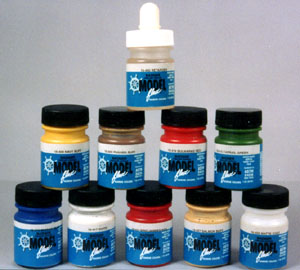 Those
of you who prefer acrylic paints need to check out the line of paints
BADGER produces under the MODELflex and FREAKflex labels. They're fast
drying and can be masked over in about ten minutes or so. If there's a
down side to them, it's the fact that you need to remove the masking as
quickly as possible after painting. This tends to eliminate our practice
of starting seven or eight different models, do part of the masking and
then set'em on the shelf for the next three months before we get back
to a given project.
Those
of you who prefer acrylic paints need to check out the line of paints
BADGER produces under the MODELflex and FREAKflex labels. They're fast
drying and can be masked over in about ten minutes or so. If there's a
down side to them, it's the fact that you need to remove the masking as
quickly as possible after painting. This tends to eliminate our practice
of starting seven or eight different models, do part of the masking and
then set'em on the shelf for the next three months before we get back
to a given project.
As it stands right now, there's 137 colors in the Railroad Colors line, 14 Military Colors that are keyed to FS numbers, 14 Automotive Colors, along with Flat, Satin and Gloss coats and 56 Marine (Ship) Colors. There's also Dull, Matte and Gloss coats, along with Retarder that will slow down the drying time and help prevent clogging your airbrush tip.
In fact the latest colors in the Marine Colors line are shown in the photo. One of the bottles is Matte Coat and the one with the eyedropper cap is your Retarder.
Figure painters haven't been left out, with 60 colors available in the FREAKflex line. Shades include such delightful choices as Asphyxia Blue, Nosferatu Flesh , Dried Blood Red and Buried Alive Brown. Despite the names, some of these colors would be perfect matches for various armor and aircraft colors. Just because they sound strange doesn't mean you should reject them out of hand.
Prices in all cases is a very reasonable $3.25 for a 1-ounce bottle.
Despite the widespread use of airbrushes -and even spray cans- you can't get away from the fact that you still need to use conventional brushes in order to finish a given project. Even if you're just doing a little touchup on small details, real brushes are a necessity.
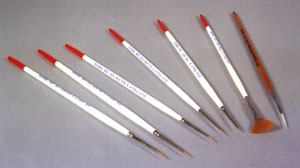 FLOQUIL
produces a line of excellent detail brushes, some under their own name
and some under the Poly S brand. Most utilize red sable bristles and will
allow you to do detail work that you'd normally be afraid to tackle.
FLOQUIL
produces a line of excellent detail brushes, some under their own name
and some under the Poly S brand. Most utilize red sable bristles and will
allow you to do detail work that you'd normally be afraid to tackle.
The photo shows seven different brushes selected from an extensive range. From left to right, they are 3/0, 5/0, 10/0, 20/0 and 25/0. Then there's an 8/0 fan and a 5/0 liner. Most of us are familiar with the 3/0 - 25/0 detail brushes, but the fan and liner brushes bring us to a screaming halt.
In a nutshell, the fan brush is useful in blending one color into another. Obviously it's not going to be of much value with acrylics and only some value where enamels are concerned. It comes into it's own with oils because of the paint's extended drying time.
The liner brush does exactly what the name implies, enables you to paint long, thin lines. It'd be great for outlining on figures and I can imagine some value on certain car models as well.
You can expect to find the FLOQUIL line of paint brushes at your local hobby shop. If not, ask the owner to order a selection. Cost varies, but is usually in the $5 - $7 each bracket. Not bad at all when you consider what the same size brush will cost you in an art supply store.
THE TESTOR CORPORATION has made numerous additions to their line of Model Master tools. While not new, strictly speaking (meaning they've become available over the last several months), they may as well be if you're not familiar with them. So, let's run down the list:
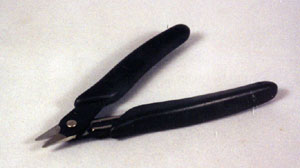 First
up is a Micro Shear Photo Etch Trimmer. While at first glance they look
like an oversize pair of sprue cutters, look again. The jaws are designed
to do exactly what the name implies, shear, in a manner similar to a pair
of scissors. Because of the tight tolerances and the short jaw length,
they'll make clean cuts through photo etch frets. This ability will minimize
the risk of twisting or bending photo etch parts. $19.99.
First
up is a Micro Shear Photo Etch Trimmer. While at first glance they look
like an oversize pair of sprue cutters, look again. The jaws are designed
to do exactly what the name implies, shear, in a manner similar to a pair
of scissors. Because of the tight tolerances and the short jaw length,
they'll make clean cuts through photo etch frets. This ability will minimize
the risk of twisting or bending photo etch parts. $19.99.
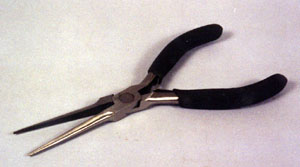 There
are times when long nose tweezers won't do the job and conventional pliers
are just too bulky…so what do you do? An obvious solution would be to
add a pair of these Long Nose Pliers to your tool drawer. Solidly built
with a tight box joint, smooth jaws and cushioned grips, these would be
more accurately described as needlenose pliers. They're exactly the type
you're likely to find on a jeweler's bench. Well worth the $12.50 price
tag.
There
are times when long nose tweezers won't do the job and conventional pliers
are just too bulky…so what do you do? An obvious solution would be to
add a pair of these Long Nose Pliers to your tool drawer. Solidly built
with a tight box joint, smooth jaws and cushioned grips, these would be
more accurately described as needlenose pliers. They're exactly the type
you're likely to find on a jeweler's bench. Well worth the $12.50 price
tag.
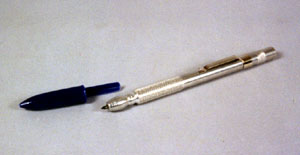 Since
we've all developed a passion for recessed panel detail, scribers have
become an essential tool. There are all kinds of scriber configurations,
so it's basically a question of which one lights your fire. Consider then,
this Scriber. Contrary to the more familiar one-piece, curved-tip designs,
this one looks like a fat drafting pen holder. Permanently mounted at
one end is a piece of carbide lead. The design makes the use of scribing
guides mandatory, but I personally think it's also easier to use since
the required technique would be virtually identical to drawing with a
pencil. And the $5.49 price ain't bad either.
Since
we've all developed a passion for recessed panel detail, scribers have
become an essential tool. There are all kinds of scriber configurations,
so it's basically a question of which one lights your fire. Consider then,
this Scriber. Contrary to the more familiar one-piece, curved-tip designs,
this one looks like a fat drafting pen holder. Permanently mounted at
one end is a piece of carbide lead. The design makes the use of scribing
guides mandatory, but I personally think it's also easier to use since
the required technique would be virtually identical to drawing with a
pencil. And the $5.49 price ain't bad either.
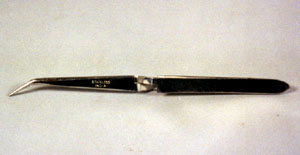 Like
knives, you can never have too many tweezers. Build models long enough
and you become familiar with the wonderful world of cross-action or locking
tweezers. They do exactly what their name says…open when you squeeze them
and close when you release pressure. This allows you to use them as clamps
or to hold small parts for painting.
Like
knives, you can never have too many tweezers. Build models long enough
and you become familiar with the wonderful world of cross-action or locking
tweezers. They do exactly what their name says…open when you squeeze them
and close when you release pressure. This allows you to use them as clamps
or to hold small parts for painting.
Most cross-action tweezers are straight, with either small or wide jaws. Well and good, but many's the time when you need to get into a tight area and the straight jaws just won't get the job done. This pair of Locking Tweezers have tapered jaws that bend at around 30 degrees. Their slender design and angled jaws give you the ability to handle work that would otherwise be difficult to impossible. Made in India from Stainless Steel, they're priced at $4.95.
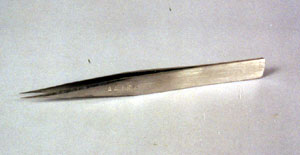 These
needlepoint Straight Tweezers are quite capable of picking up a single
hair from a smooth tabletop. Made in India from non-magnetic Stainless
Steel, these would be an excellent choice if you're looking to buy your
first pair of good tweezers. Particularly when you consider the $3.95
price. Could you pay more? Sure. I've got a couple of pair made in Italy
that cost around $20 each. I wouldn't sell'em at any price. But the ones
described here will do nearly as much as the Italian ones will…and for
a lot less money.
These
needlepoint Straight Tweezers are quite capable of picking up a single
hair from a smooth tabletop. Made in India from non-magnetic Stainless
Steel, these would be an excellent choice if you're looking to buy your
first pair of good tweezers. Particularly when you consider the $3.95
price. Could you pay more? Sure. I've got a couple of pair made in Italy
that cost around $20 each. I wouldn't sell'em at any price. But the ones
described here will do nearly as much as the Italian ones will…and for
a lot less money.
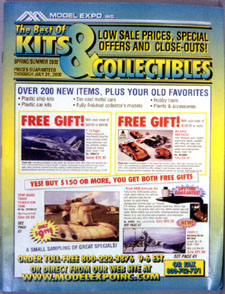 Thanks
to mailing lists, we all get swamped with catalogs. Never mind that the
internet was supposed to lead to a more or less paperless society. The
catalogs keep coming. Human nature, I guess.
Thanks
to mailing lists, we all get swamped with catalogs. Never mind that the
internet was supposed to lead to a more or less paperless society. The
catalogs keep coming. Human nature, I guess.
At any rate, MODEL EXPO now has a catalog out called The Best of Kits & Collectibles. This is their Spring/Summer 2000 issue and prices are good thru July 31, 2000.
It's comprised of 72 pages, the majority of which are plastic kits. Most of the major manufacturers are represented, including Airfix, Heller, Revell-Monogram, Lindberg, Minicraft, AMT, Italeri, Testors and Tamiya. Prices range from good deals to mind blowing. For example, Tamiya's $124.95 kit of the 1/35 scale Dragon Wagon is priced at $89.99. Prefer aircraft? How about the 1/48 Swordfish for $49.99 and an extra $9.99 for the photoetch set? Or $79.99 for the 1/32 Tamiya F-4J Phantom II, F-4C/D Phantom II or F-14A Tomcat? Or…oh, heck, just go visit their website or I'll wind up going thru the whole catalog.
See y'all next month.

Previous: Contents


